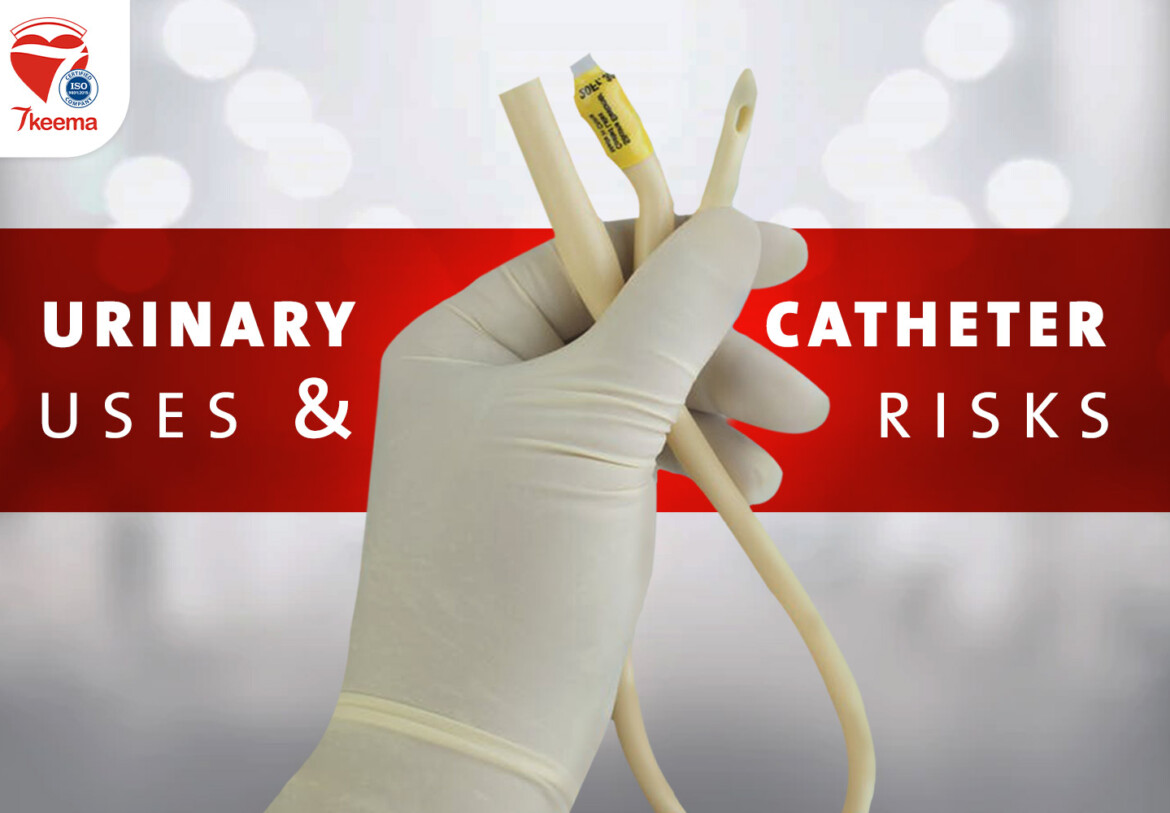Medical stuff is weird yet efficient and to the goal. Throughout history, medical tools have been improved in an obvious way to reach optimum health services. The Urinary Catheter is maybe one of the weirdest medical tools ever, yet serving a major role and couldn’t be replaced in many cases.
However, using a urinary catheter could be a little bit tricky, as it could lead to many serious complications if it were wrongly installed or used for a long time, which could directly threaten the patient health.
A urinary catheter could be mandatory and irreplaceable throughout some cases, especially for the elderly, as they could face many issues concerning urinating normally, whether losing control or being incapable of doing so. It could also be used for post-surgery recovery, which could be highly useful for those who cannot move and help themselves to the restroom.
In contrast, the wrong use of a catheter, whether due to issues throughout installing procedures or keeping it for a long time, could lead to some catastrophic outcomes, making it not as easy as it sounds to install a catheter.
Out of this point, we can deduce the importance of having a specialist to provide such type of care whenever needed, without underestimation.
In fact, it should be provided by at least a specialist nurse, if not a doctor, who would be taking into consideration safety on top of his priorities, as well he would be highly trained to deal with such private service to avoid any mistake or problem that could lead to complications.
Therefore, 7keema has provided a whole service for the urinary catheter installation and removal, offered by specialists nurses, who are experienced in such service, which guarantees no mistake that would lead to any complication or severe issue. Moreover, 7keema provides many home nursing services that could be integrated to offer the patient full healthcare at home.
Accordingly, we dedicated this article to fully explaining such a subject, mentioning details, including urinary catheter types and how they work. But first, we should get to know more about what’s a catheter and when it’s required.

What’s A Urinary Catheter?
The catheter is originally a medical procedure that would be required in many cases, which plays a massive role in extracting urine from the bladder.
A tube would be inserted from the urethra, made from rubber, plastic, or silicon, while the outer tube end is connected to a drainage bag to collect urine. A catheter could be used for several periods, according to the patient’s needs and to the urinary catheter type as well.
Clearly, it depends on how the patient is dealing with his recovery process; it could just be a temporary procedure that wouldn’t last more than a few days, while in many other cases, it could last for long times. The patient just has to adapt to having it.
When A Urinary Catheter is Used?
Basically, a doctor is the one who decides to install a catheter according to his diagnosing and estimating the patient’s needs, and then it would be left for the nursing team to implement, who will take any measurement to avoid any complication that could hurt the patient.
For many reasons, a patient would lose the ability to urinate normally; that’s when a urinary catheter is used basically. Accumulating a huge amount of urine in the bladder would directly affect kidneys and the bladder itself. Severe cases would reach a total kidneys failure.
Here’re some of the main reasons for a urinary catheter:
– During baby delivery for ladies, especially when the back needle is used. It’s an injection used to reduce labor pains when it’s usually used as a pain killer for spinal nerve infections patients, which has a side effect on the normal urine extraction process.
– Before, during, and after different sorts of surgeries, a urinary catheter could be massively needed.
– A catheter could be used to deliver some kinds of medications for bladder cancer patients.
– The urinary catheter helps men who have a prostate enlargement issue urinate.
– It could be used due to weak muscles and nerves around the bladder area, which prevent urine accumulation.
– Any sort of urethra injuries would affect the urinating ability, which requires a catheter.
– Having any sort of stones, whether kidneys, gallbladder, or bladder, would require installing a urinary catheter.
– Suffering from the urinating system or bladder cancer.
– In case of urethra blockage due to any reason, especially for men, it would be mandatory to install a urinary catheter to extract urine, avoid accumulation, and prevent many severe complications.
– When a newborn baby is delivered with any genetic flaw concerning the urinating system, it would be required to install a catheter.
Moreover, a catheter could be used to control urine incontinence, which’s more likely for the elderly to have. It’s when the patient loses control of the urine during a hard laugh or cough. It could follow the urinating process that the patient couldn’t control for sure that the urine stopped from coming out completely.
In fact, urine incontinence is one of the lists that has a title of geriatric diseases, and it’s more likely for the elderly to have such diseases, or better to say that risk increases by aging, which would prevent them from having a normal life. The geriatric phase, in general, would represent a massive challenge to overcome, which would lead to asking for help from a home nursing service to provide integrated elderly care at home.

Is It Painful To Install A Catheter?
When a urinary catheter is needed due to one of the mentioned reasons, patients would fear feeling pain during the installing procedure and wondering what pain level would be caused as well.
Many medical opinions reveal that it’s not as painful as people thought. Yet, it could cause discomfort while having a catheter, which’s due to not urinating normally.
Alternatively, many other opinions reveal that it could not be painful at all, and if any pain is felt would not be serious in most cases.
On the other side, using a urinary catheter would be mandatory for many cases and irreplaceable; it only varies how long it would be needed. For many cases, it could be for a temporary short period, while for others, it could be for a temporary short period that could take longer.
Therefore, 7keema offers a whole home nursing service for catheter installing and removal. Specialist nurses provide this service at home, and it’s easy to reach through a mobile application.
According to the different needs, many urinary catheter types are available to be used.
Urinary Catheter Types
Urinary catheter types are variable to fit every case need according to the period it would be used.
Urinary catheter types could be mentioned as follows:
– Intermittent Catheter
One of the main urinary catheter types is used for temporary periods.
In fact, it could be used only when it’s needed that the patient would install it in whenever required then remove it several times during the day.
It’s only used to unload any urine accumulation from the bladder, and the outer side of the tube would be left without a drainage bag to be connected to the toilet tub directly.
The intermittent catheter would lead to many risks and complications if it’s wrongly used, between which we can mention:
– Urinary tract infections.
– Blood into the urine.
– Bladder stones.
– Narrow urethra.

– Indwelling Catheter
One of the urinary catheter types is stable used for long periods, and it’s also called the permanent catheter.
It’s not used several times or been removed and installed, and it’s used only for one time, yet for a long period.
This urinary catheter type includes two other minor urinary catheter types that vary in the installation technique.
Urethral Indwelling catheter: one of the urinary catheter types that last for a long time, and it’s inserted through the urethra directly into the bladder. And the outer side of the tube that connected to a drainage bag.
Suprapubic indwelling catheter: this urinary catheter type is inserted through the patient’s belly into the bladder. Professional staff should provide it.
Not to mention the risks and complications of any mistake while inserting both urinary catheter types, between which we can mention the following:
– Bladder cramps.
– Catheter blockage, requiring immediate medical intervention.
– General discomfort feeling, leading to a massive pain in some cases.
– Condom Catheter
One of the urinary catheter types is significant only for men, as it’s connected externally through a condom.
Similar to previous urinary catheter types, the condom catheter would lead to many risks and complications as well, between which we can mention the following:
– Urinary tract infection when used for a long time.
– Skin infection due to constant friction.
– Urethral obstruction.
How To Pick from Urinary Catheter Types
It’s only decided by a specialist doctor, according to many factors:
– What the issue the catheter would fix.
– How long it would be used.
– Patient lifestyle and how he is responding to treatment.
– The material of tube, plastic, silicon, or rubber.
– The way of inserting the catheter.
– Tube and drainage bag volume to fit the patient’s need.
Catheter Risks & Complications
Despite all its benefits and uses for many cases in general, the urinary catheter would lead to many serious and severe complications.
For instance, inserting any urinary catheter types would require a specialist to avoid mistakes. Not to mention how confidential and tricky such a procedure is.
Inserting a catheter without taking all the precaution measurements is considered a huge mistake.
Accordingly, 7keema provides the catheter service through its home nursing services to maintain such tricky cases and help patients avoid complications. The service provides a specialist nurse, highly trained and well experienced to provide the service. In order to make it easier and more accessible for every patient, this service could be ordered through a mobile application.
To get the full image of how inserting any of the urinary catheter types could be risky, let’s spread out the main risks and complications of a wrong installed catheter:
– Urinary tracts infections.
– Blood into the urine.
– Accumulating stones into kidneys could lead to a major kidney infection.
– High risk of developing bladder stones.
– Odd urine color; it gets darker than usual.
– Burn feeling around the bladder and reproductive organs.
– Odd urine smell.
– Lower back pain.
– In major and severe cases, it would lead to kidney failure.
– A catheter would lead to an obvious increase in the body temperature, which tends to be a fever.
– Due to the catheter material and many substances used in many urinary catheter types, a certain type of allergy or a body reflection could be developed.
Urinary Catheter Complications Prevention
Few steps would be followed to secure a safe and secured catheter installation, and the service provider should follow certain precautions, between which we can mention the following:
– The service provider should wash hands carefully using warm water and soap before touching the catheter tube.
– Keeping the drainage bag on a lower level than the bladder.
– Ensuring that there’re no turns or knots along the tube, and it should be monitored all along using time.
– Disinfecting skin around the catheter insertion point at least twice per day.
– Having a reasonable amount of water intake all along the day.
– Avoid laying down right on the tube.
7keema For home Nursing
In fact, 7keema aims to put healthcare into a different level of comfort, using home nursing to claim the best to patients wherever they are. It has also included a whole home nursing service to offer a safe and healthy catheter installation and removal. Not to mention many home nursing services that would be integrated to provide full home care.
Throughout the urinary catheter installation service procedure, 7keema ensures providing a specialist nurse with a high level of experience and professionalism, allowing the nurse – whether male or female according to the patient gender – to provide the best service quality away from any risks or complications.
7keema for home nursing is actually a mobile application where you can order any sort of service as simple as a button click.








